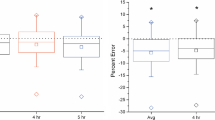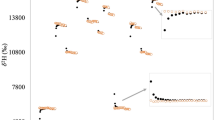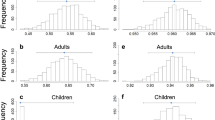Abstract
Background/Objectives:
The method of choice for measuring total energy expenditure in free-living individuals is the doubly labeled water (DLW) method. This experiment examined the behavior of natural background isotope abundance fluctuations within and between individuals over time to assess possible methods of accounting for variations in the background isotope abundances to potentially improve the precision of the DLW measurement.
Subjects/Methods:
In this work, we measured natural background variations in 2H, 18O and 17O in water from urine samples collected from 40 human subjects who resided in the same geographical area. Each subject provided a urine sample for 30 consecutive days. Isotopic abundances in the samples were measured using Off-Axis Integrated Cavity Output Spectroscopy.
Results:
Autocorrelation analyses demonstrated that the background isotopes in a given individual were not temporally correlated over the time scales of typical DLW studies. Using samples obtained from different individuals on the same calendar day, cross-correlation analyses demonstrated that the background variations of different individuals were not correlated in time. However, the measured ratios of the three isotopes 2H, 18O and 17O were highly correlated (R2=0.89–0.96).
Conclusions:
Although neither specific timing of DLW water studies nor intraindividual comparisons were found to be avenues for reducing the impact of background isotope abundance fluctuations on DLW studies, strong inter-isotope correlations within an individual confirm that use of a dosing ratio of 8‰:1‰ (0.6 p.p.m.:1 p.p.m.) optimizes DLW precision. Theoretical implications for the possible use of 17O measurements within a DLW study require further study.
This is a preview of subscription content, access via your institution
Access options
Subscribe to this journal
Receive 12 print issues and online access
$259.00 per year
only $21.58 per issue
Buy this article
- Purchase on Springer Link
- Instant access to full article PDF
Prices may be subject to local taxes which are calculated during checkout





Similar content being viewed by others
References
Ogden C, Carroll M, Curtin L, McDowell M, Tabak C, Flegal K . Prevalence of overweight and obesity in the United States, 1999-2004. J Am Med Assoc 2006; 295: 1549–1555.
Osorio-Costa F, Rocha G, Dias M, Carvalheira J . Epidemiological and molecular mechanisms aspects linking obesity and cancer. Arq Brasil Endocrinol Metabol 2009; 53: 213–226.
Martins D, Tareen N, Pan D, Norris K . The relationship between body mass index, blood pressure and pulse rate among normotensive and hypertensive participants in the third National Health and Nutrition Examination Survey (NHANES). Cell Mol Biol 2003; 49: 1305–1309.
Harris T, Ballardbarbasch R, Madans J, Makuc D, Feldman J . Overweight, Weight-Loss, and Risk of Coronary Heart-Disease in Older Women—the Nhanes-I Epidemiologic Follow-Up-Study. Am J Epidemiol 1993; 137: 1318–1327.
Davis M, Ettinger W, Neuhaus J . Obesity and Osteoarthritis of the Knee—Evidence from the National-Health-And-Nutrition-Examination-Survey (Nhanes I). Semin Arthritis and Rheu 1990; 20: 34–41.
Baldelli R, DeMarinis L, D'Amico E, Barnabei A, Pasimeni G, Mecule A et al. Obesity and cancer. Obesity Metabol Milan 2008; 4: 4–11.
Westerterp K, Speakman J . Physical activity energy expenditure has not declined since the 1980s and matches energy expenditures of wild mammals. Int J Obesity 2008; 32: 1256–1263.
Speakman J . Doubly-Labelled Water: Theory and Practice. Kluwer Academic publishers: New York, 1997.
Lifson N, McClintock R . Theory of use of turnover rates of body water for measuring energy and material balance. J Theor Biol 1966; 12: 46–74.
Lagerros Y, Lagiou P . Assessment of physical activity and energy expenditure in epidemiological research of chronic diseases. Eur J Epidemiol 2007; 22: 353–362.
Schoeller D . Insights into energy balance from doubly labeled water. Int J Obes 2008; 32 (Suppl 7), 572–575.
Jackson D, Djafarian K, Stewart J, Speakman J . Increased TV viewing is associated with elevated body fatness but not lower energy expenditure. Am J Clin Nutr 2009; 89: 1–6.
Manini T, Everhart J, Anton S, Schoeller D, Cummings S, Mackey D et al. Activity energy expenditure and change in body composition in late life. Am J Clin Nutr 2009; 90: 1336–1342.
Speakman J, Westerterp K . Associations between energy demands, physical activity and body composition in adult humans between 18 and 96 years of age. Am J Clin Nutr 2010; 92: 826–834.
Djafarian K, Jackson DM, Milne E, Roger P, Speakman J . Doubly-labeled water: Multi- and two-point methods in young children. Int J Pediatr Obes 2010; 3: 102–110.
Schoeller D, Kushner R, Jones P . Validation of Doubly Labeled Water for Measuring Energy-Expenditure During Parenteral-Nutrition. Am J Clin Nutr 1986; 44: 291–298.
Trabulsi J, Troiano. R, Subar A, Sharbaugh C, Kipnis V, Schatzkin A et al. Precision of the doubly labeled water method in a large-scale application: evaluation of a streamlined-dosing protocol in the Observing Protein and Energy Nutrition (OPEN) study. Eur J Clin Nutr 2003; 57: 1370–1377.
Speakman J . The role of technology in the past and future development of the doubly-labelled water method. Isotopes Envrion Health Stud 2005; 41: 335–343.
Horvitz M, Schoeller D . Natural abundance deuterium and 18-oxygen effects on the precision of the doubly labeled water method. Am J Physiol Endocrinol Metab 2001; 280: E965–E972.
Schoeller D . Energy expenditure from doubly labeled water: some fundamental considerations in humans. Am J Clin Nutr 1983; 38: 999–1005.
Ritz P, Cole TJ, Couet C, Coward WA . Precision of DLW energy expenditure measurements: contribution of natural abundance variations. Am J Physiol Endocrinol Metab 1996; 270: E164–E169.
Speakman J, Racey P . The equilibrium concentration of O-18 in body-water—implications for the accuracy of the doubly-labeled water technique and a potential new method of measuring Rq in free-living animals. J Theor Biol 1987; 127: 79–95.
Barkan E, Luz B . High precision measurements of 17O/16O and 18O/16O ratios in H2O. Rapid Communications in Mass Spectrometry. 2005; 19: 3737–3742.
Berman E, Gupta M, Gabriell C, Garland T, McDonnell J . High-frequency field deployable isotope analyzer for hydrological applications. Water Resour Res 2009; 45: W10201.
Lis G, Wassenaar L, Hendry M . High-precision laser spectroscopy D/H and 18O/16O measurements of microliter natural water samples. Anal Chem 2008; 80: 287–293.
Wassenaar L, Hendry M, Chostner V, Lis G . High resolution pore water δ2H and δ18O measurements by H2O(liquid)-H2O(vapor) equilibration. Environ Sci Technol 2008; 42: 9262–9267.
Penna D, Stenni B, Sanda M, Wrede S, Bogaard T, Gobbi A et al. On the reproducibility and repeatability of laser absorption spectroscopy measurements for δ2H and δ18O isotopic analysis. Hydrol Earth Sys Sci 2010; 7: 2975–3014.
Lyon SW, Desilets SLE, Troch PA . A tale of two isotopes: differences in hydrograph separation for a runoff event when using dD versus d18O. Hydrol Process 2009; 23: 2095–2101.
Wassenaar L, Van Wilgenburg S, Larson K, Hobson K . A groundwater isoscape (δD, δ18O) for Mexico. J Geochem Explor 2009; 102: 123–136.
Berman ESF, Fortson SL, Snaith SP, Gupta M, Baer DS, Chery I et al. Direct analysis of δ2H and δ18O in natural and enriched human urine using laser-based, Off-Axis Integrated Cavity Output Spectroscopy. Anal Chem 2012; 84: 9768–9773.
Berman ESF, Levin NE, Landais A, Li S, Owano T . Measurement of δ18O, δ17O, and 17O-excess in water by off-axis integrated cavity output spectroscopy and isotope ratio mass spectrometry. Anal Chem 2013; 85: 10392–10398.
Baer DS, Paul JB, Gupta M, O’Keefe A . Sensitive absorption measurements in the near-infrared region using off-axis integrated-cavity-output spectroscopy. Appl Phys B 2002; 75: 261–265.
Certificates of Analysis. Los Gatos Research: Mountain View, CA, 2010, Document Numbers 908-Z008-9201 and 908-Z008-9401.
Thorsen T, Shriver T, Racine N, Richman BA, Schoeller D . Doubly labeled water analysis using cavity ring-down spectroscopy. Rapid Comm Mass Spectrom 2011; 25: 3–8.
Leen JB, Berman E, Liebson L, Gupta M . Spectral contaminant identifier for off-axis integrated cavity output spectroscopy measurements of liquid water isotopes. Rev Sci Instrum 2012; 83: 044305.
Schoeller D, Ravussin E, Schutz Y, Acheson K, Baertschi P, Jequier E . Energy expenditure by doubly labeled water: validation in humans and proposed calculation. Am J Physiol 1986; 250: R823–R830.
Luz B, Barkan E . Variations of 17O/16O and 18O/16O in meteoric waters. Geochim Cosmochim Acta 2010; 74: 6276–6286.
Haggarty P, McGaw BA, Franklin MF . Measurement of fractionated water loss and CO2 production using triply labelled water. J Theor Biol 1988; 134: 291–308.
Speakman JR, Racey PA . Doubly labelled water—errors in the evaluation of oxygen isotope turnover due to temporal variation in CO2 production do not always covary with dilution space estimate. J Theor Biol 1989; 141: 547–556.
Speakman JR, Racey PA . Measurement of CO2 production by the doubly labeled water technique. J Appl Physiol 1986; 61: 1200–1202.
Suszczynski C. ISOTEC. Personal Communication 2014.
Acknowledgements
We thank Ruixin Guo for statistical expertise, Susan Fortson for laboratory assistance and Thomas Owano for helpful discussions. We are particularly grateful to Professor Bill Wong for providing us with some enriched isotopic standards. This work was supported by NIH SBIR 1R43DK093362–01.
Author Contributions
ESFB is the principal investigator and involved in the study design, data collection, sample analysis, data analysis, statistical analysis and manuscript preparation. ELM involved in the study design, sample collection, data collection and manuscript preparation. TS involved in the sample collection and data collection. SPS involved in the sample analysis and data analysis. JRS involved in the study design, modeling, data interpretation and manuscript preparation.
Author information
Authors and Affiliations
Corresponding author
Ethics declarations
Competing interests
ESFB discloses that she is employed by Los Gatos Research, the manufacturer of the OA-ICOS laser absorption spectrometers. SPS discloses that he was formerly employed by Los Gatos Research.
Rights and permissions
About this article
Cite this article
Berman, E., Melanson, E., Swibas, T. et al. Inter- and intraindividual correlations of background abundances of 2H, 18O and 17O in human urine and implications for DLW measurements. Eur J Clin Nutr 69, 1091–1098 (2015). https://doi.org/10.1038/ejcn.2015.10
Received:
Revised:
Accepted:
Published:
Issue Date:
DOI: https://doi.org/10.1038/ejcn.2015.10
This article is cited by
-
First use of triply labelled water analysis for energy expenditure measurements in mice
Scientific Reports (2022)
-
Maximizing precision and accuracy of the doubly labeled water method via optimal sampling protocol, calculation choices, and incorporation of 17O measurements
European Journal of Clinical Nutrition (2020)



